11 Herbal Teas For Period Cramps

Herbal teas have been a long-standing remedy for period cramps, and it's easy to see why.
The unique properties of certain herbs make them a natural fit for soothing menstrual discomfort. For example, Glycyrrhiza glabra, also known as licorice root, contains anti-inflammatory compounds that help reduce swelling and ease crampy pains. When consumed as a tea, these compounds work quickly to calm the uterus and promote relaxation. Another herb that's particularly effective is Zingiber officinale, or ginger. Its active ingredient, gingerol, has potent anti-inflammatory and pain-relieving properties. Drinking ginger tea can help break down prostaglandins, hormone-like substances that cause the uterus to contract and lead to cramps.
This can provide quick relief from intense period pain. Paeonia lactiflora, or peony root, is another herb often used to alleviate period cramps. Its anti-inflammatory and sedative properties help to calm the nervous system, promoting relaxation and reducing muscle tension. This can make a big difference in how you feel during your period, allowing you to focus on your daily activities without being held back by pain. Using herbal teas for period cramps is not only a natural solution, but also a convenient one. You can brew a cup of tea whenever you need it, and adjust the amount of herbs to suit your taste.
This way, you can take control of your period pain and find a sense of comfort and relief.
- 1. Glycyrrhiza glabra
- 2. Zingiber officinale
- 3. Paeonia lactiflora
- 4. Ginkgo biloba
- 5. Vitex agnus-castus
- 6. Angelica archangelica
- 7. Lavandula angustifolia
- 8. Cimicifuga racemosa
- 9. Valeriana officinalis
- 10. Foeniculum vulgare
- 11. Rosmarinus officinalis
1. Glycyrrhiza glabra

Glycyrrhiza glabra teas contains compounds like glycyrrhizin, flavonoids, and saponins that help alleviate period cramps.
Glycyrrhizin has anti-inflammatory properties, which can reduce inflammation and ease pain in the uterus. Flavonoids, such as kaempferol and quercetin, have antioxidant and anti-inflammatory effects that can help relax the uterine muscles and reduce cramping. Saponins in the tea have a gentle anti-spasmodic effect, which can also help calm the uterine muscles and ease cramps.
By combining these properties, Glycyrrhiza glabra teas may be a natural and effective way to manage period cramps.
- Gather 1 tablespoon of dried Glycyrrhiza glabra root. You can buy it from a health store or online.
- Use 1 cup of boiling water to make the tea. Pour the boiling water over the Glycyrrhiza glabra root in a cup.
- Let the tea steep for 5-7 minutes. This will help the flavors and benefits of the root come out.
- Strain the tea using a coffee filter or a fine-mesh sieve to remove the root particles. Discard the root.
- Drink the tea warm or at room temperature. You can add honey to taste if you prefer a sweeter tea.
2. Zingiber officinale

Zingiber officinale teas contains a compound called gingerol, which has anti-inflammatory properties.
These properties help to reduce pain and swelling in the body, including menstrual cramps caused by prostaglandins. Gingerol also contains a compound called shogaol, which has a similar effect. Shogaol blocks the production of prostaglandins, which are hormone-like substances that cause the uterus to contract and lead to cramps.
By reducing the production of these substances, Zingiber officinale teas helps to alleviate menstrual cramp pain.
- Gather 1 cup of water and 1 tablespoon of dried Zingiber officinale root (fresh root or powder also works)
- Boil the water in a pot and let it cool for 1-2 minutes
- Add the Zingiber officinale root to the cooled water and let it steep for 5-10 minutes
- Strain the tea into a cup and discard the root
- Drink the tea as needed to help relieve period cramps, ideally 2-3 times a day
Zingiber Officinale Tea on Amazon
FGO Organic Ginger Tea, 100 Count, Eco-Conscious Tea Bags, Caffeine Free, Packaging May Vary (Pack of 1)
Disclaimer: We earn a commission if you click this link and make a purchase at no additional cost to you.
3. Paeonia lactiflora
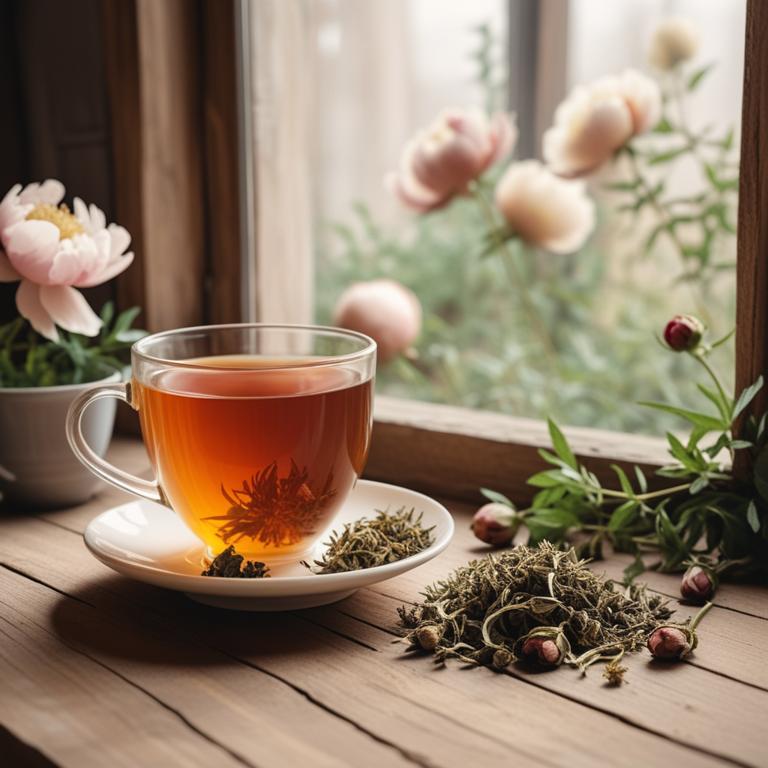
Paeonia lactiflora teas contains bioactive constituents like paeoniflorin, paeonol, and alkaloids that help alleviate period cramps.
Paeoniflorin, a key compound, has anti-inflammatory and antispasmodic properties that reduce pain and muscle spasms. Paeonol, on the other hand, has a sedative effect, which can help relax the uterus and reduce cramping. Alkaloids in the tea also have a mild analgesic effect, further reducing period pain.
By reducing inflammation and relaxing the uterine muscles, Paeonia lactiflora teas helps to alleviate period cramps naturally.
- Gather 1 cup of dried Paeonia lactiflora roots and 2 cups of water.
- Combine the roots and water in a saucepan and bring to a boil.
- Reduce heat and simmer for 10-15 minutes.
- Strain the liquid and discard the roots. Add honey to taste.
- Drink 1 cup of the tea 2-3 times a day as needed for period cramps.
4. Ginkgo biloba

Ginkgo biloba teas contains flavonoids and terpenoids, which are active constituents that help to ease period cramps.
Flavonoids, particularly quercetin and kaempferol, have anti-inflammatory properties that reduce swelling and pain in the uterus. Terpenoids, such as bilobalide, have a sedative effect that can help relax the muscles in the uterus and reduce cramping. The flavonoids and terpenoids in Ginkgo biloba teas also work together to improve blood flow to the uterus, reducing congestion and cramping.
By reducing inflammation, relaxing muscles, and improving blood flow, Ginkgo biloba teas can provide relief from period cramps.
- Gather 1 cup of boiling water, 1 tablespoon of dried Ginkgo biloba leaves, and a tea infuser.
- Place the tea infuser in a cup and add the dried Ginkgo biloba leaves.
- Pour the boiling water over the Ginkgo biloba leaves in the tea infuser.
- Let the tea steep for 5-7 minutes, then remove the infuser.
- Drink the tea as needed for period cramp relief, ideally 2-3 cups a day.
5. Vitex agnus-castus
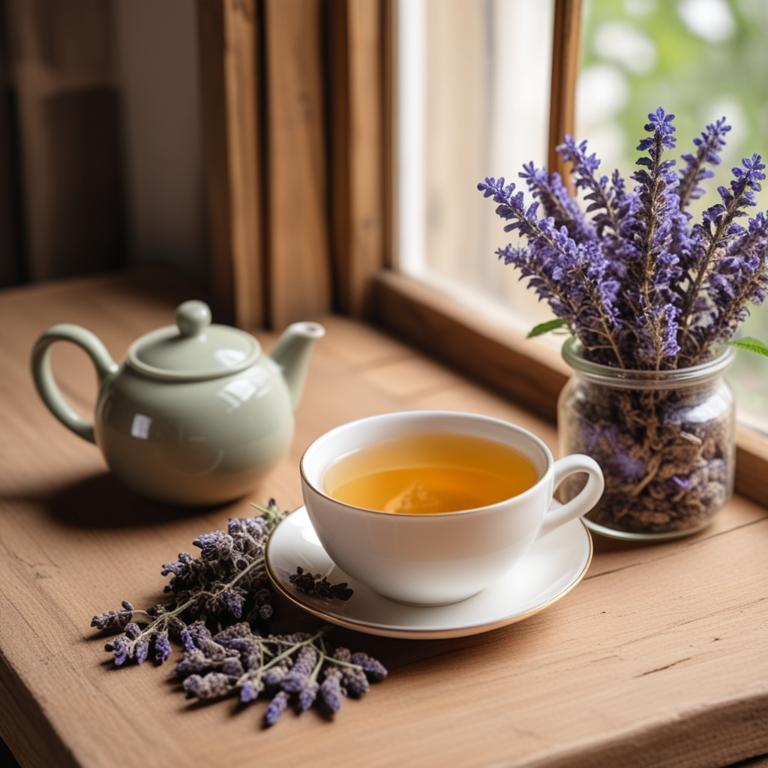
Vitex agnus-castus teas contains iridoid glycosides, specifically aucubin and agnuside, which are known to have anti-inflammatory and pain-relieving properties.
These compounds help to reduce inflammation and ease cramping in the uterus, providing relief from menstrual pain. The flavonoids present in Vitex agnus-castus teas, such as kaempferol and quercetin, also have antioxidant properties that help to protect the body from free radicals and promote overall health. Additionally, the plant's estrogens and lignans work to regulate hormonal balance and improve menstrual cycle regularity, which can help to reduce the severity of period cramps.
By reducing inflammation and regulating hormones, Vitex agnus-castus teas can provide effective relief from period cramps.
- Get dried Vitex agnus-castus seeds. Use 1-2 tablespoons for a cup of boiling water.
- Boil 1 cup of water in a pot.
- Add 1-2 tablespoons of dried Vitex agnus-castus seeds to the boiling water.
- Let it steep for 5-10 minutes, then strain the tea into another cup.
- Drink the tea 2-3 times a day to help with period cramps.
6. Angelica archangelica
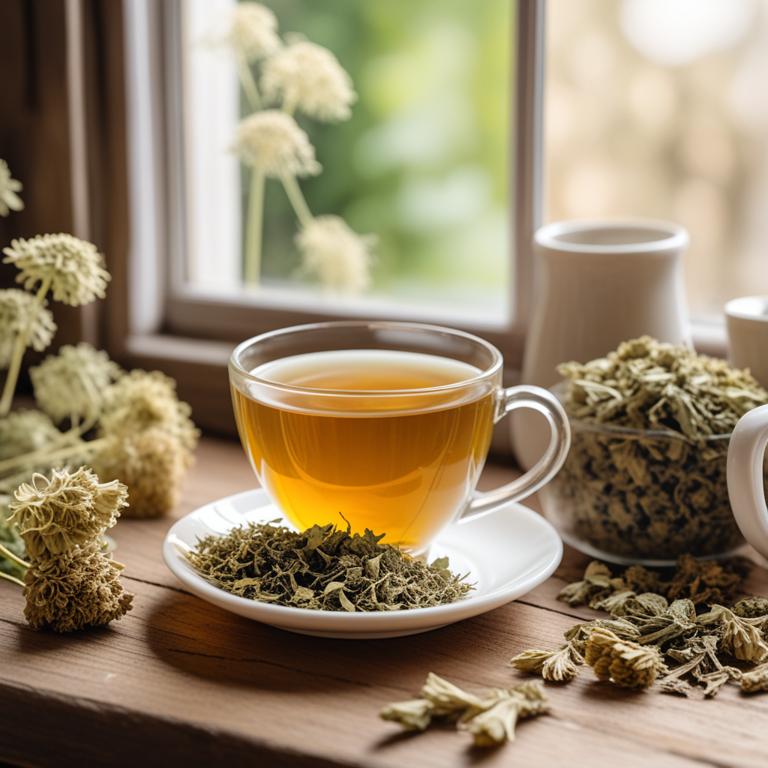
Angelica archangelica teas contains a number of bioactive constituents that make it a good choice for managing period cramps.
These compounds include ferulic acid, beta-sitosterol, and ligustilide, which have anti-inflammatory and pain-relieving properties. The anti-inflammatory properties of ferulic acid and beta-sitosterol help to reduce inflammation and swelling in the uterus, while ligustilide's pain-relieving properties can help to ease cramp pain. The antispasmodic properties of ligustilide also help to relax the smooth muscle in the uterus, reducing the severity of cramps.
By reducing inflammation and relaxing the uterine muscles, Angelica archangelica teas can help to provide relief from period cramps.
- Gather 1 cup of fresh or dried Angelica archangelica roots. You can buy them from a health food store or online.
- Use a cup to measure 8 oz of boiling water. Pour the water over the Angelica roots in a heat-resistant cup or mug.
- Let the mixture steep for 5-10 minutes. Strain the tea with a fine-mesh sieve or cheesecloth to remove the roots.
- Add 1 tablespoon of honey to the tea, if desired, for sweetness. You can also add other herbs like ginger or peppermint for extra flavor.
- Drink the tea warm or at room temperature, 2-3 times a day, for relief from period cramps.
7. Lavandula angustifolia

Lavandula angustifolia teas contains rosmarinic acid and linalool, which are powerful anti-inflammatory compounds.
These compounds work by blocking the production of prostaglandins, hormone-like substances that cause muscle contractions and pain. The anti-inflammatory and pain-relieving properties of linalool also help to reduce swelling and ease cramping. Additionally, the tea's calming effects can help to reduce stress and anxiety, which can contribute to period cramp severity.
By reducing inflammation and promoting relaxation, Lavandula angustifolia teas can help to alleviate period cramp symptoms.
- Gather 1 cup of dried Lavandula angustifolia flowers.
- Boil 1 cup of water in a pot.
- Add 2 tablespoons of dried Lavandula angustifolia flowers to the boiling water.
- Reduce heat and let it steep for 5-7 minutes, then strain the tea.
- Drink the tea 2-3 times a day to help relieve period cramps.
8. Cimicifuga racemosa
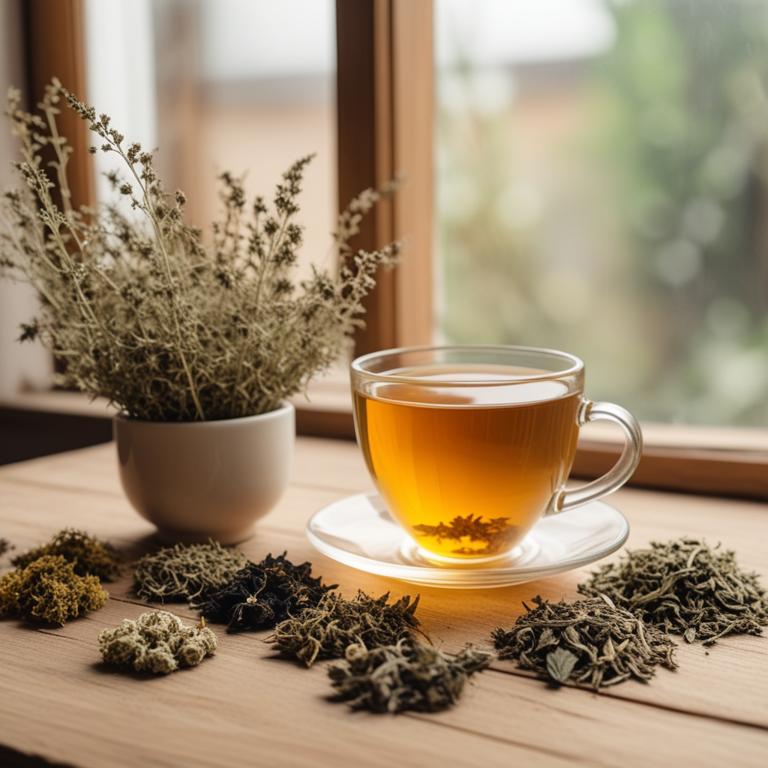
Cimicifuga racemosa teas contains a compound called actein, as well as other bioactive constituents like cimicifugic acid and ferulic acid.
These compounds have anti-inflammatory properties that help to reduce prostaglandins, hormone-like substances that cause muscle contractions and pain during menstrual cramps. The ferulic acid in Cimicifuga racemosa teas also has antioxidant properties, which can help to reduce inflammation and alleviate pain. By reducing inflammation and prostaglandins, Cimicifuga racemosa teas can help to provide relief from menstrual cramps and other symptoms associated with PMS.
Regular consumption of Cimicifuga racemosa teas may help to reduce the severity and frequency of menstrual cramps.
- Gather 1 teaspoon of dried Cimicifuga racemosa root and 1 cup of boiling water.
- Let the root steep in the boiling water for 5-7 minutes.
- Strain the liquid into a cup using a fine-mesh sieve or cheesecloth.
- Add honey or lemon to taste, if desired. Stir well.
- Drink the tea 2-3 times a day as needed to help relieve period cramps.
9. Valeriana officinalis
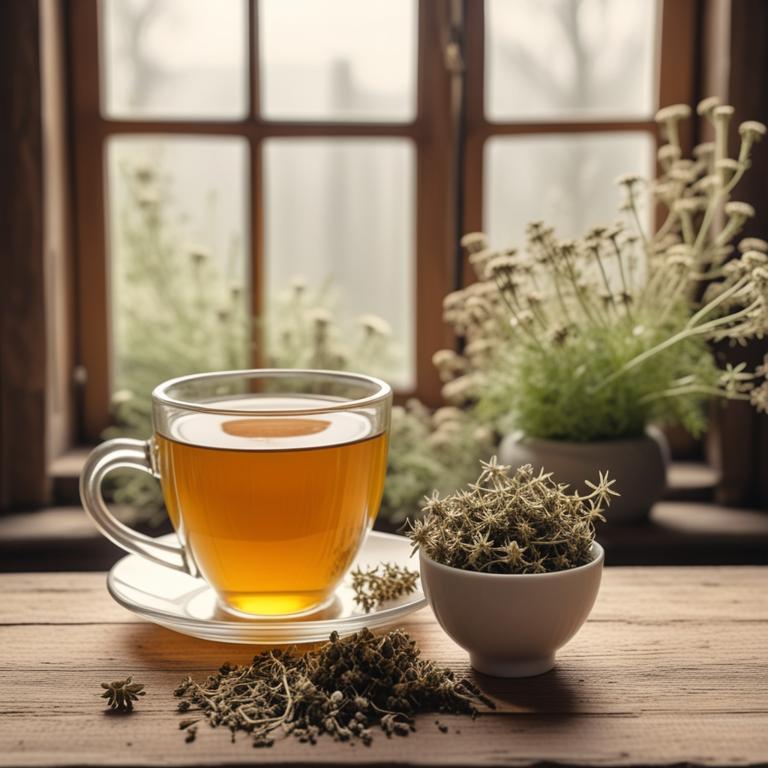
Valeriana officinalis teas contains a number of bioactive constituents, including valerenic acid, isovalerenic acid, and valepotriates.
These compounds have sedative and anti-inflammatory properties, which help to relax the uterine muscles and reduce spasms that cause period cramps. The anti-inflammatory properties of valerenic acid and isovalerenic acid also help to reduce swelling and pain in the lower abdomen. Additionally, the valepotriates in Valeriana officinalis teas have a spasmolytic effect, which helps to calm the uterine muscles and relieve cramping.
By reducing inflammation and relaxing the uterine muscles, Valeriana officinalis teas can help to alleviate period cramps and make menstruation more comfortable.
- Gather 1 cup of boiling water and 1 teaspoon of dried Valeriana officinalis root.
- Measure 1 cup of boiling water and pour it over 1 teaspoon of dried root in a cup.
- Let the mixture steep for 5-7 minutes.
- Strain the tea using a fine-mesh sieve or cheesecloth and discard the solids.
- Drink the tea warm or at room temperature, 2-3 times a day for relief from period cramps.
10. Foeniculum vulgare
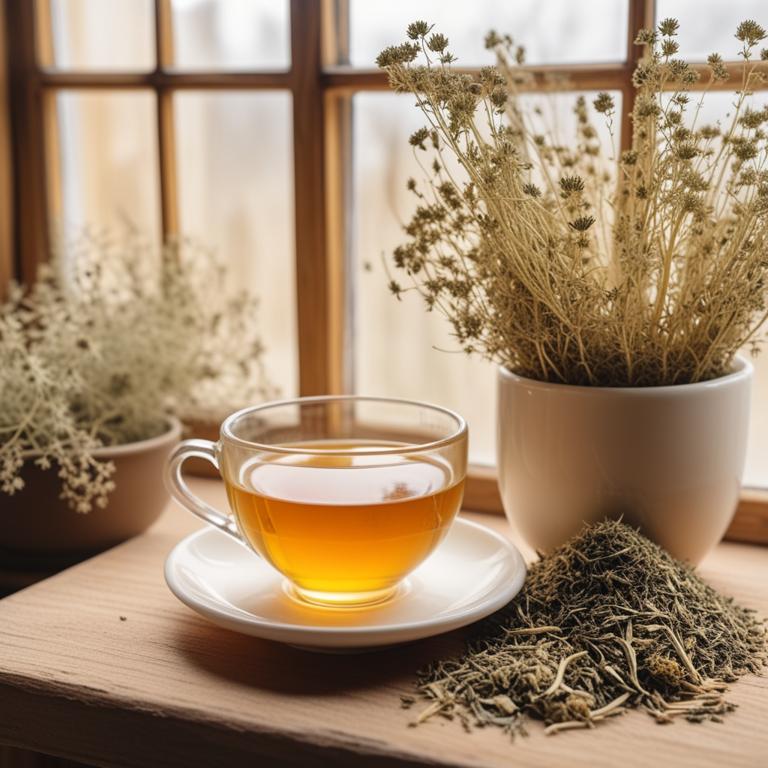
Foeniculum vulgare teas contains compounds like limonene and anethole, which have anti-inflammatory properties.
These compounds help reduce swelling and ease cramps by blocking prostaglandins, hormone-like substances that cause pain. The tea also contains fenchone and anisaldehyde, which have a calming effect on the uterus, helping to regulate menstrual cycles. The antispasmodic properties of fennel tea help relax the uterine muscles, reducing cramps and discomfort.
Drinking Foeniculum vulgare teas regularly may help alleviate period cramps by providing relief from inflammation and muscle spasms.
- Gather 1 cup of dried Foeniculum vulgare seeds (aniseeds) and 1 cup of boiling water.
- Steep the aniseeds in the boiling water for 5-7 minutes, then strain the mixture.
- Add 1 tablespoon of honey to the tea for taste, if desired.
- Drink 1 cup of the tea 2-3 times a day, or as needed for period cramp relief.
- Store any leftover tea in the fridge for up to 24 hours and reheat before drinking.
11. Rosmarinus officinalis

Rosmarinus officinalis teas contains essential oils like borneol, camphor, and borneol acetate, which have anti-inflammatory and antispasmodic properties.
These compounds help relax the uterine muscles and reduce pain caused by period cramps. The tea's antioxidant properties, due to the presence of carnosic acid, help reduce inflammation and oxidative stress in the body. The rosmarinic acid in the tea has a protective effect on the blood vessels, improving blood flow and reducing prostaglandin production, which contributes to period cramp pain.
By reducing inflammation and relaxing the uterine muscles, Rosmarinus officinalis teas can help alleviate period cramp pain and discomfort.
- Gather 1 cup of fresh Rosmarinus officinalis leaves or 1 teaspoon of dried leaves.
- Bring 1 cup of water to a boil in a pot.
- Add the Rosmarinus officinalis leaves to the boiling water and remove from heat.
- Steep for 5-7 minutes, then strain the mixture into a cup.
- Drink the tea as needed to help relieve period cramps, up to 3 times a day.